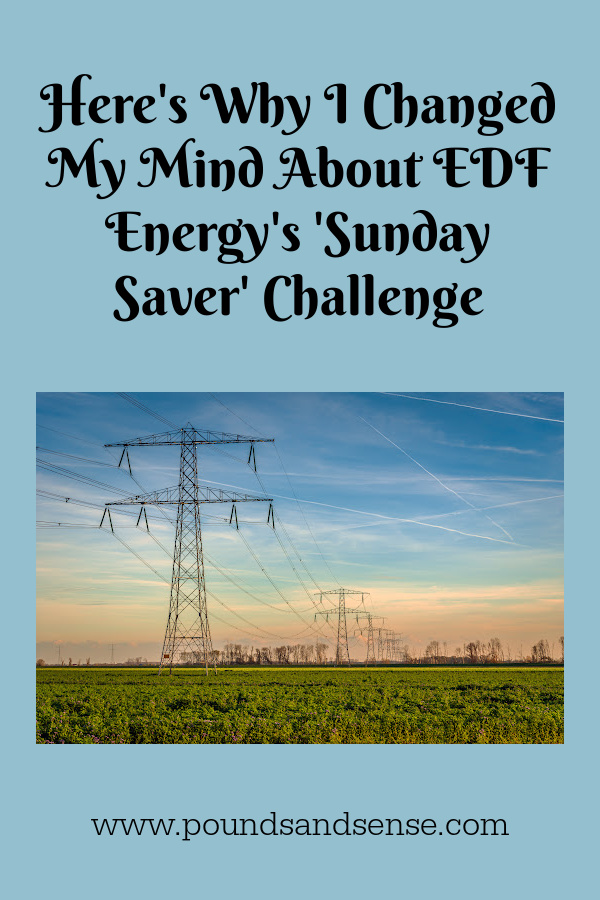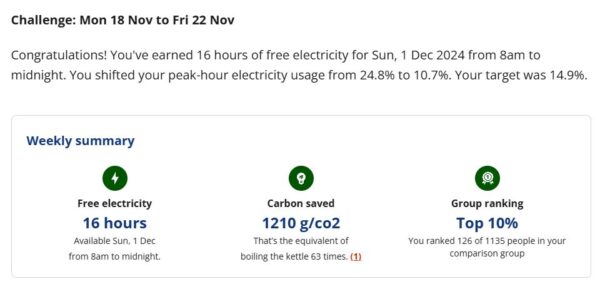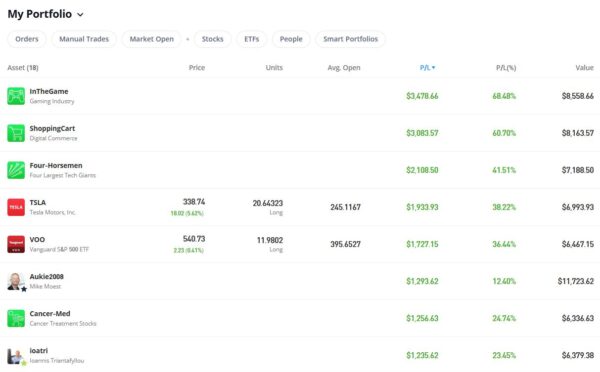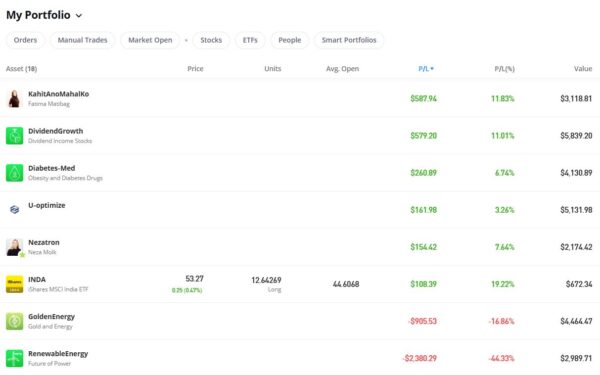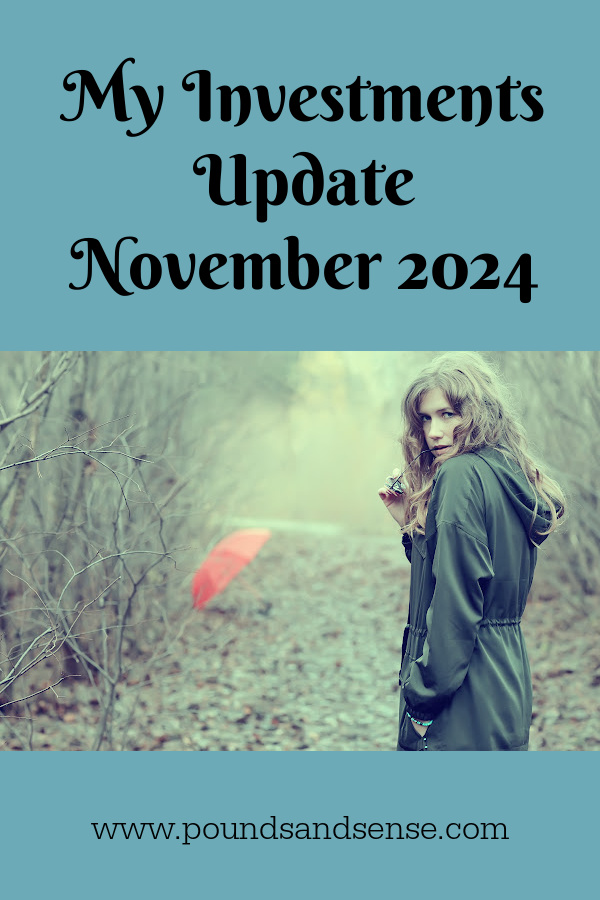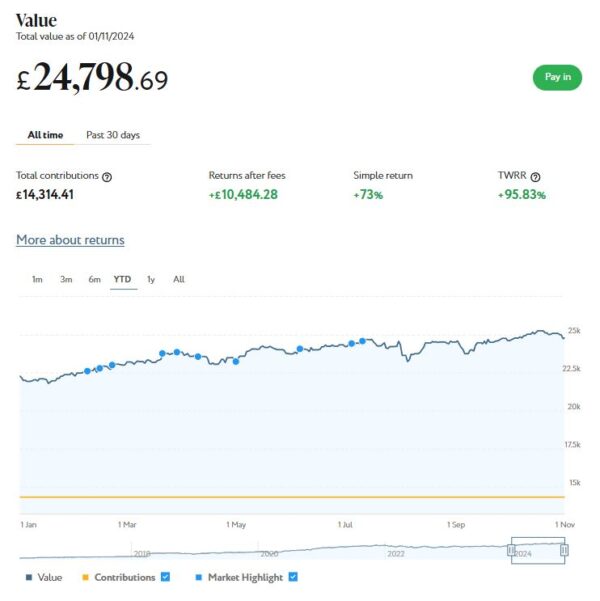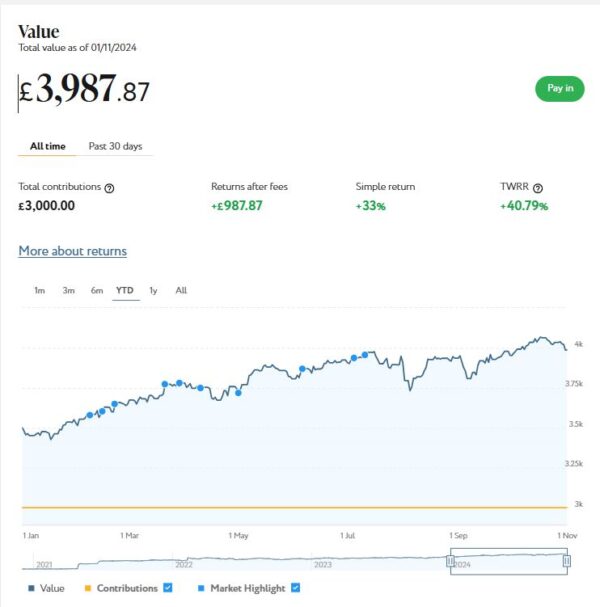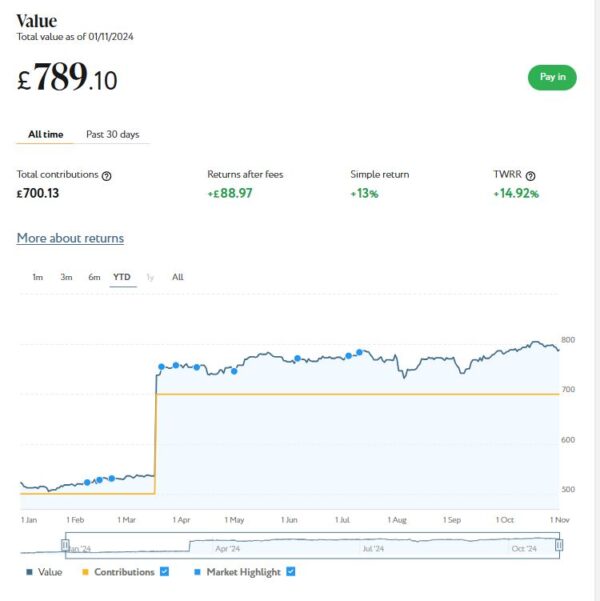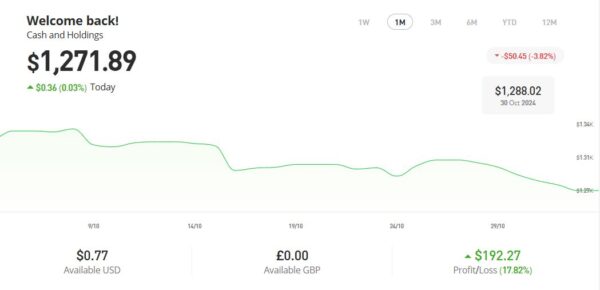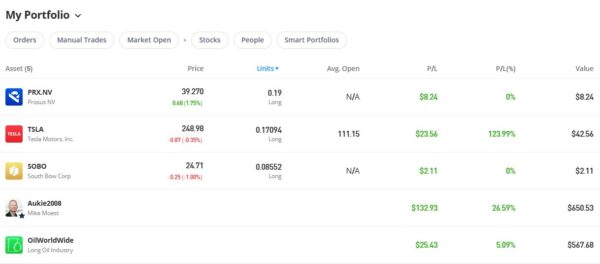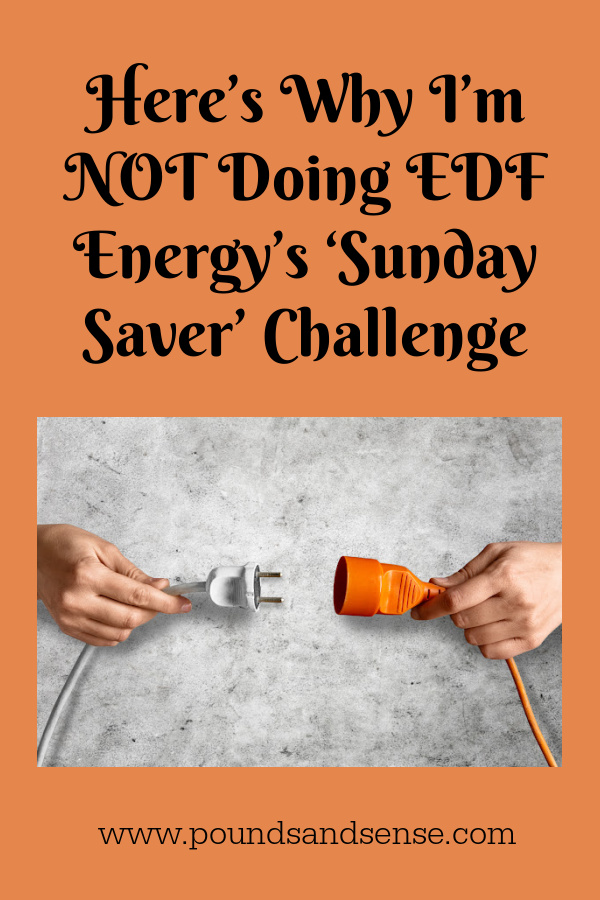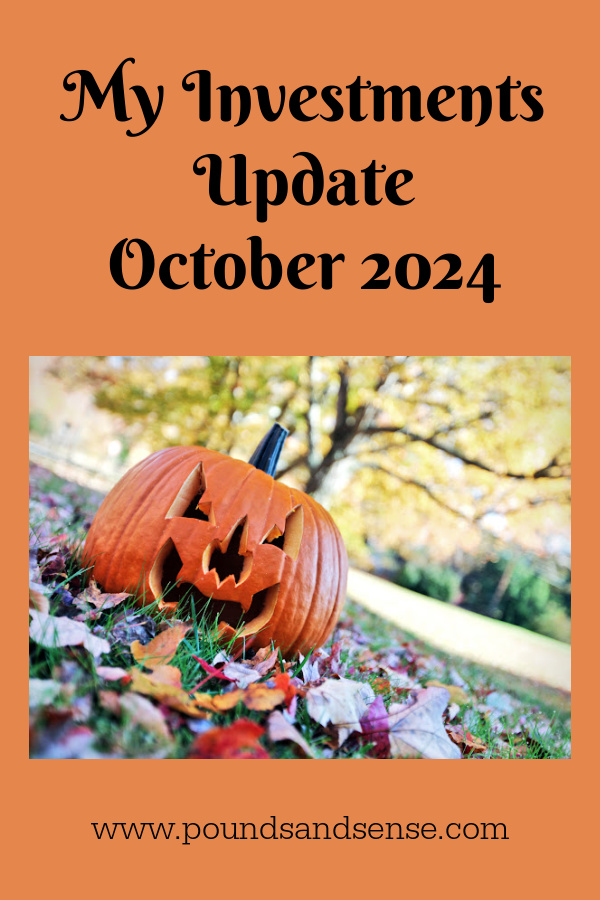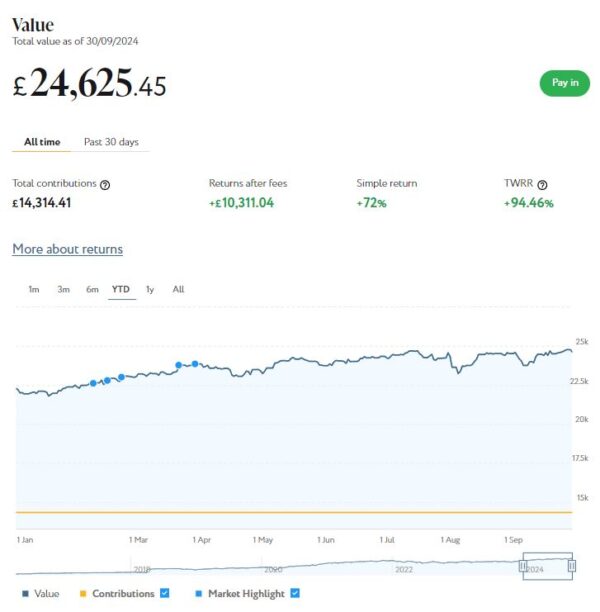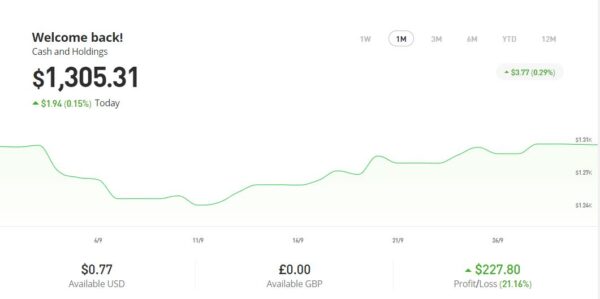My Investments Update – December 2024
Here is my latest monthly update about my investments. You can read my November 2024 Investments Update here if you like.
I’ll begin as usual with my Nutmeg Stocks and Shares ISA. This is the largest investment I hold other than my Bestinvest SIPP (personal pension).
As the screenshot below for the year to date shows, my main Nutmeg portfolio is currently valued at £25,822 (rounded up). Last month it stood at £24,799, so that is an impressive increase of £1,023.
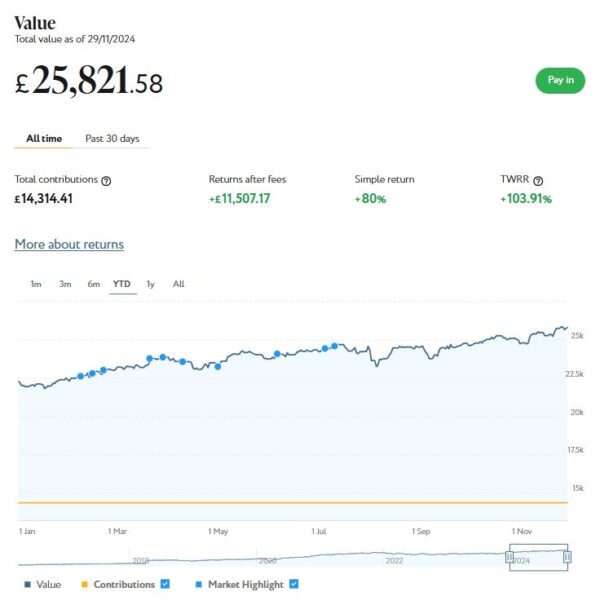
Apart from my main portfolio, I also have a second, smaller pot using Nutmeg’s Smart Alpha option. This is now worth £4,157 compared with £3,988 a month ago, a rise of £169. Here is a screen capture showing performance over the year to date.
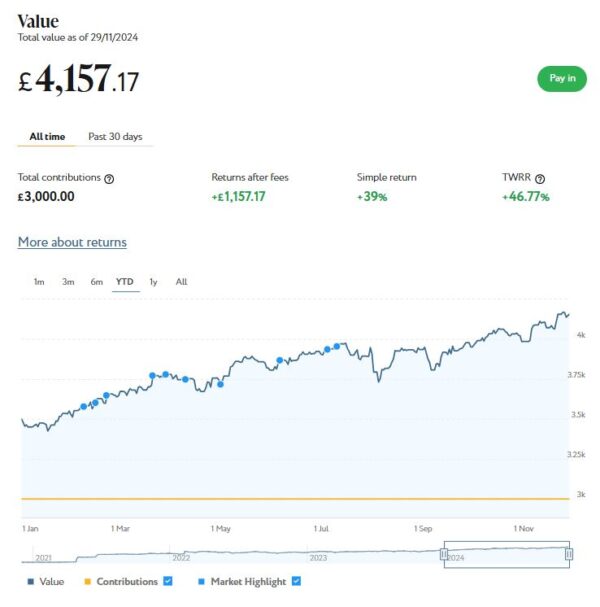
Finally, at the start of December 2023 I invested £500 in one of Nutmeg’s new thematic portfolios (Resource Transformation). In March I also invested a further £200 from referral bonuses. As you can see from the YTD screen capture below, this portfolio is now worth £818 (rounded up) compared with £789 last month, a rise of £29.
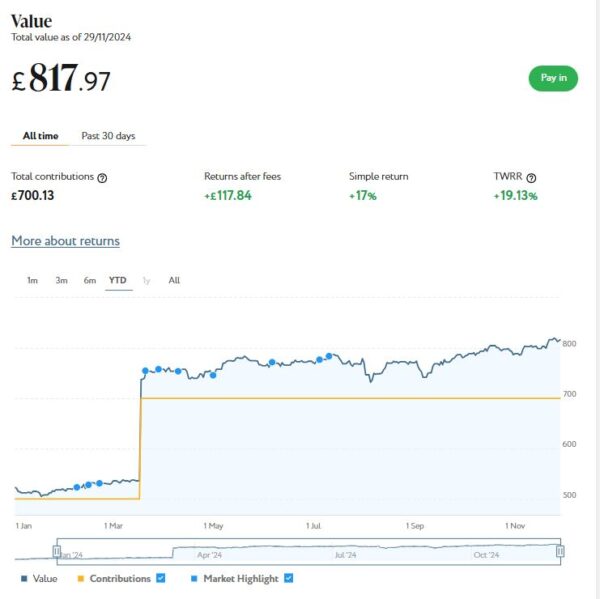
As you can see, November was a good month for my Nutmeg investments. The overall value has risen by £1,221 or 4.13% since the start of November. They are also up by £4,482 or 17.03% since the start of the year.
You can read my full Nutmeg review here. If you are looking for a home for your annual ISA allowance, based on my overall experience over the last eight years, they are certainly worth considering. They offer self-invested personal pensions (SIPPs), Lifetime ISAs and Junior ISAs as well.
- Note that I am no longer an affiliate for Nutmeg. That means you won’t find any affiliate links in my review (or anywhere else on PAS). And you will no longer see the no-fees-for-six-months offer I used to promote as an affiliate. However, the better news is that you can still get six months free of any management fees by registering with Nutmeg via my Refer a Friend link. I will receive a gift voucher if you do this, which is duly appreciated
Don’t forget, also, that the current tax year began on 6 April 2024. Despite some predictions to the contrary, you still have a full £20,000 tax-free ISA allowance for 2024/25. As from this year, you can open any number of ISAs with different providers in the same tax year, as long as you don’t exceed your overall £20,000 allowance. So opening a stocks and shares ISA with Nutmeg won’t prevent you from also opening one with another S&S ISA provider (should you wish to) later in the financial year.
Moving on, I also have investments with P2P property investment platform Assetz Exchange. These continue to generate steady returns. Assetz Exchange focuses on lower-risk properties (e.g. sheltered housing). I put an initial £100 into this in mid-February 2021 and another £400 in April. In June 2021 I added another £500, bringing my total investment up to £1,000.
Since I opened my account, my AE portfolio has generated a respectable £220.04 in revenue from rental income. Capital growth has slowed, though, in line with UK property values generally.
At the time of writing, 12 of ‘my’ properties are showing gains, 4 are breaking even, and the remaining 18 are showing losses. My portfolio of 34 properties is currently showing a net decrease in value of £44.11, meaning that overall (rental income minus capital value decrease) I am up by £175.93. That’s still a decent return on my £1,000 and does illustrate the value of P2P property investments for diversifying your portfolio. And it doesn’t hurt that with Assetz Exchange most projects are socially beneficial as well.
The overall fall in capital value of my AE investments is obviously a little disappointing. But it’s important to remember that until/unless I choose to sell the investments in question, it is largely theoretical, based on the latest price at which shares in the property concerned have changed hands. The rental income, on the other hand, is real money (which in my case I’ve reinvested in other AE projects to further diversify my portfolio).
To control risk with all my property crowdfunding investments nowadays, I invest relatively modest amounts in individual projects. This is a particular attraction of AE as far as i am concerned. You can actually invest from as little as 80p per property if you really want to proceed cautiously.
- As I noted in this blog post, Assetz Exchange is particularly good if you want to compound your returns by reinvesting rental income. This effectively boosts the interest rate you are receiving. Personally, once I have accrued a minimum of £10 in rental payments, I reinvest this money in either a new AE project or one I have already invested in (thus increasing my holding). Over time, even if I don’t invest any more capital, this will ensure my investment with AE grows at an accelerating rate and becomes more diversified as well.
My investment on Assetz Exchange is in the form of an IFISA so there won’t be any tax to pay on profits, dividends or capital gains. I’ve been impressed by my experiences with Assetz Exchange and the returns generated so far, and intend to continue investing with them. You can read my full review of Assetz Exchange here. You can also sign up for an account on Assetz Exchange directly via this link [affiliate]. Bear in mind that, as from this financial year (2024/25), you can open more than one IFISA per year.
In 2022 I set up an account with investment and trading platform eToro, using their popular ‘copy trader’ facility. I chose to invest $500 (then about £412) copying an experienced eToro trader called Aukie2008 (real name Mike Moest).
In January 2023 I added to this with another $500 investment in one of their thematic portfolios, Oil Worldwide. I also invested a small amount I had left over in Tesla shares.
As you can see from the screen captures below, my original investment totalling $1,022.26 is today worth $1,315.34, an overall increase of $293.08 or 28.67%.
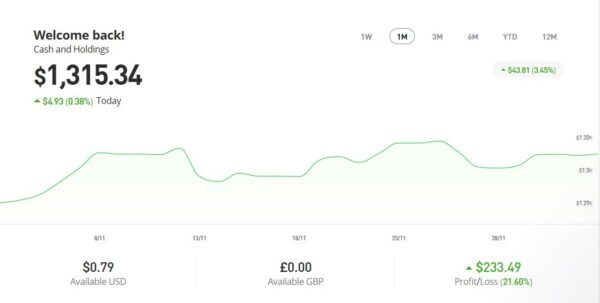
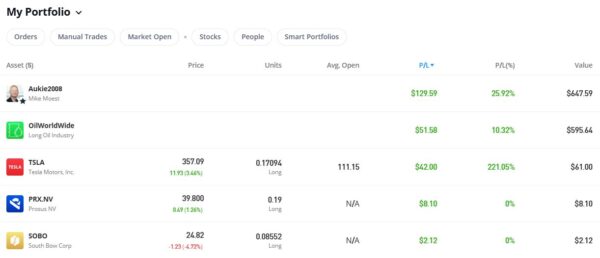
You can read my full review of eToro here. You may also like to check out my more in-depth look at eToro copy trading. I also discussed thematic investing with eToro using Smart Portfolios in this recent post. The latter also reveals why I took the somewhat contrarian step of choosing the oil industry for my first thematic investment with them.
As you can see, my Oil WorldWide investment is showing a respectable if not outstanding profit of 10.32%. My copy trading investment with Aukie2008 has been doing better, with an overall 25.95% profit. To be fair, I have held the latter investment a bit longer.
You might also notice that I have small holdings in Prosus NV, a Dutch internet group, and South Bow, a Canadian energy infrastructure company. To be honest I don’t understand how I acquired these, but I assume they are some sort of bonus I have been awarded. In any event, I am happy to have them in my portfolio!
- eToro also offer the free eToro Money app. This allows you to deposit money to your eToro account without paying any currency conversion fees, saving you up to £5 for every £1,000 you deposit. You can also use the app to withdraw funds from your eToro account instantly to your bank account. I tried this myself and was impressed with how quickly and seamlessly it worked. You can read my blog post about eToro Money here. Note that it can also serve as a cryptocurrency wallet, allowing you to send and receive crypto from any other wallet address in the world.
I had two more articles published in November on the excellent Mouthy Money website. The first is Ten Ways to Boost Your Bank Balance in the Run-up to Christmas. As Christmas approaches, many of us are feeling the pinch, with the cost of gifts, food and festivities adding up. And that’s before you even factor in the cost of living crisis, tax increases, benefit cuts, and so on. So in this article I set out a variety of ways you may be able to boost your income in the weeks leading up to the big day.
Also in November Mouthy Money published my article Get Fit, Make Money – How to Profit from Fitness Apps. In this article I revealed a variety of methods by which you may be able to get fit and boost your bank balance at the same time.
As I’ve said before, Mouthy Money is a great resource for anyone interested in money-making and money-saving. From the range of articles published in November, I particularly enjoyed this guide to saving money by selling stuff on eBay and other websites by regular MM contributor Shoestring Jane. Jane writes mainly about money saving and frugal living. You can see all of her articles for Mouthy Money via this web page.
I also published (or republished) several posts on Pounds and Sense in November. Some are no longer relevant, but I have listed the others below.
Here’s Why I Changed My Mind About EDF Energy’s ‘Sunday Saver’ Challenge was a follow up to last month’s Here’s Why I’m Not Doing EDF Energy’s ‘Sunday Saver’ Challenge. I got a lot of comments about my earlier article and – as you may gather – that changed my mind somewhat about the scheme. So in this post I explained why I had a rethink, and what happened when I signed up to the challenge myself in November. Please do read the comments by me and others on this post as well.
In Update on my eToro Virtual Portfolio, I brought readers up to date with how my eToro VP has been doing and discussed what lessons could be learned from it. As I say in the article, anyone joining the eToro trading and investing platform automatically gets a $100,000 virtual portfolio in which they can experiment with different investing styles and strategies. I found it very interesting to revisit my VP a year on. I was pleased to discover that since my previous VP update, and despite the fact I hadn’t really paid it much attention, performance had turned around and the port was showing a good profit (unfortunately virtual as well!). As ever there were winners and losers, and these will inform my real-money trading as well.
With Christmas fast approaching, last month I published What Are the Best Video Calling Tools for Older People? For older people (in particular) video calling can provide a great way of connecting with far-flung family and friends if – for whatever reason – they can’t meet in person. In this article I set out the main options available and shared a few hints and tips for making the most of them.
And in Twelve Great Christmas Gift Ideas for Older People (That Aren’t Socks) I set out 12 suggestions for presents for older friends and relatives that – based on my experience as an older person myself – should put a smile on their faces! If you’re struggling for ideas for gifts for older friends and relatives, check this out
Lastly, a reminder that you can also follow Pounds and Sense on Facebook or Twitter (or X as we have to call it now). Twitter/X is my number one social media platform and I post regularly there. I share the latest news and information on financial (and other) matters, and other things that interest, amuse or concern me. So if you aren’t following my PAS account on Twitter/X, you are definitely missing out.
- I have also just joined the new BlueSky social media network. My username there is poundsandsense.bsky.social. For the time being at least, Twitter/X will remain my main social media platform, but I will also post details of my latest blog posts, third-party articles and other financial news and resources on BlueSky for those who prefer to follow me there.
That’s all for today. I hope you are keeping safe and warm in the current Arctic weather. As always, if you have any comments or questions, feel free to leave them below. I am always delighted to hear from PAS readers
Disclaimer: I am not a qualified financial adviser and nothing in this blog post should be construed as personal financial advice. Everyone should do their own ‘due diligence’ before investing and seek professional advice if in any doubt how best to proceed. All investing carries a risk of loss.
Note also that posts on PAS may include affiliate links. If you click through and perform a qualifying transaction, I may receive a commission for introducing you. This will not affect the product or service you receive or the terms you are offered, but it does help support me in publishing PAS and paying my bills. Thank you!




